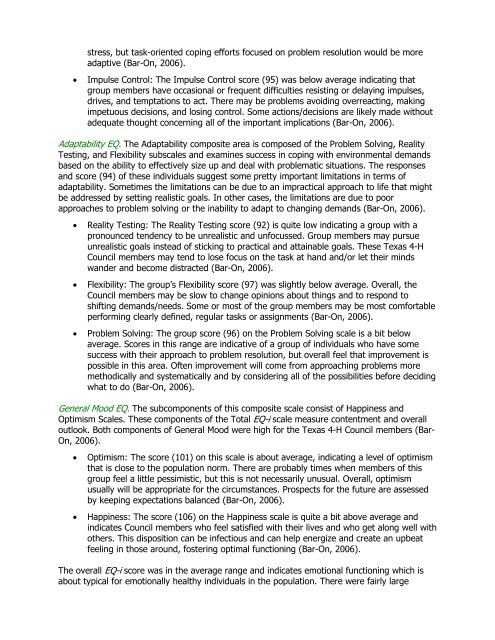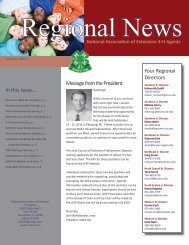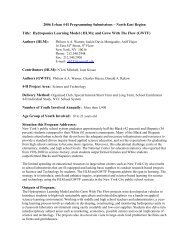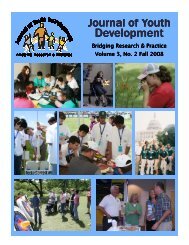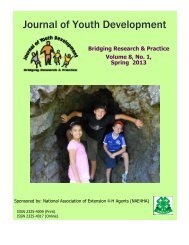Winter 2008 - Vol. 3 No. 3 - National Association of Extension 4-H ...
Winter 2008 - Vol. 3 No. 3 - National Association of Extension 4-H ...
Winter 2008 - Vol. 3 No. 3 - National Association of Extension 4-H ...
- No tags were found...
Create successful ePaper yourself
Turn your PDF publications into a flip-book with our unique Google optimized e-Paper software.
stress, but task-oriented coping efforts focused on problem resolution would be moreadaptive (Bar-On, 2006).• Impulse Control: The Impulse Control score (95) was below average indicating thatgroup members have occasional or frequent difficulties resisting or delaying impulses,drives, and temptations to act. There may be problems avoiding overreacting, makingimpetuous decisions, and losing control. Some actions/decisions are likely made withoutadequate thought concerning all <strong>of</strong> the important implications (Bar-On, 2006).Adaptability EQ. The Adaptability composite area is composed <strong>of</strong> the Problem Solving, RealityTesting, and Flexibility subscales and examines success in coping with environmental demandsbased on the ability to effectively size up and deal with problematic situations. The responsesand score (94) <strong>of</strong> these individuals suggest some pretty important limitations in terms <strong>of</strong>adaptability. Sometimes the limitations can be due to an impractical approach to life that mightbe addressed by setting realistic goals. In other cases, the limitations are due to poorapproaches to problem solving or the inability to adapt to changing demands (Bar-On, 2006).• Reality Testing: The Reality Testing score (92) is quite low indicating a group with apronounced tendency to be unrealistic and unfocussed. Group members may pursueunrealistic goals instead <strong>of</strong> sticking to practical and attainable goals. These Texas 4-HCouncil members may tend to lose focus on the task at hand and/or let their mindswander and become distracted (Bar-On, 2006).• Flexibility: The group’s Flexibility score (97) was slightly below average. Overall, theCouncil members may be slow to change opinions about things and to respond toshifting demands/needs. Some or most <strong>of</strong> the group members may be most comfortableperforming clearly defined, regular tasks or assignments (Bar-On, 2006).• Problem Solving: The group score (96) on the Problem Solving scale is a bit belowaverage. Scores in this range are indicative <strong>of</strong> a group <strong>of</strong> individuals who have somesuccess with their approach to problem resolution, but overall feel that improvement ispossible in this area. Often improvement will come from approaching problems moremethodically and systematically and by considering all <strong>of</strong> the possibilities before decidingwhat to do (Bar-On, 2006).General Mood EQ. The subcomponents <strong>of</strong> this composite scale consist <strong>of</strong> Happiness andOptimism Scales. These components <strong>of</strong> the Total EQ-i scale measure contentment and overalloutlook. Both components <strong>of</strong> General Mood were high for the Texas 4-H Council members (Bar-On, 2006).• Optimism: The score (101) on this scale is about average, indicating a level <strong>of</strong> optimismthat is close to the population norm. There are probably times when members <strong>of</strong> thisgroup feel a little pessimistic, but this is not necessarily unusual. Overall, optimismusually will be appropriate for the circumstances. Prospects for the future are assessedby keeping expectations balanced (Bar-On, 2006).• Happiness: The score (106) on the Happiness scale is quite a bit above average andindicates Council members who feel satisfied with their lives and who get along well withothers. This disposition can be infectious and can help energize and create an upbeatfeeling in those around, fostering optimal functioning (Bar-On, 2006).The overall EQ-i score was in the average range and indicates emotional functioning which isabout typical for emotionally healthy individuals in the population. There were fairly large


